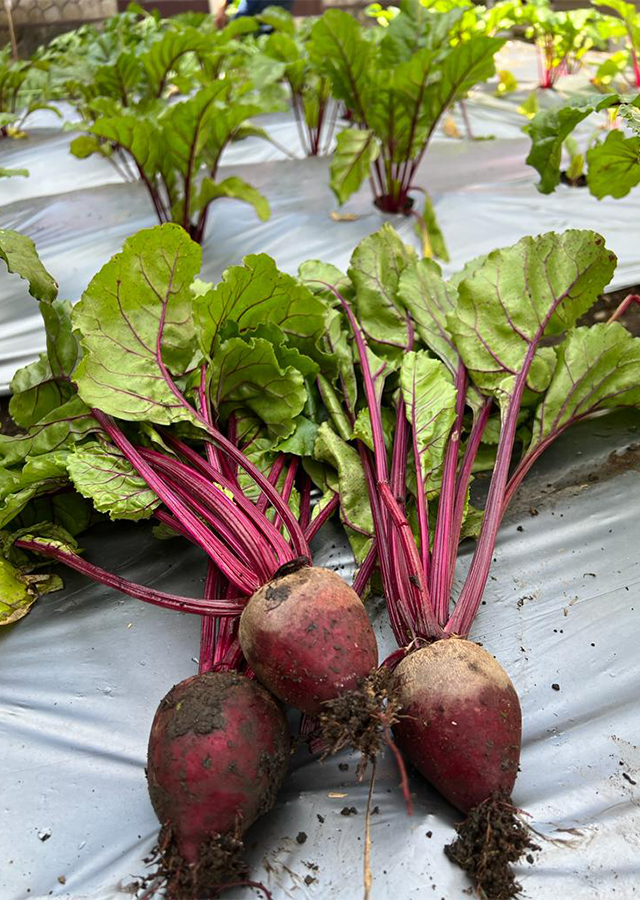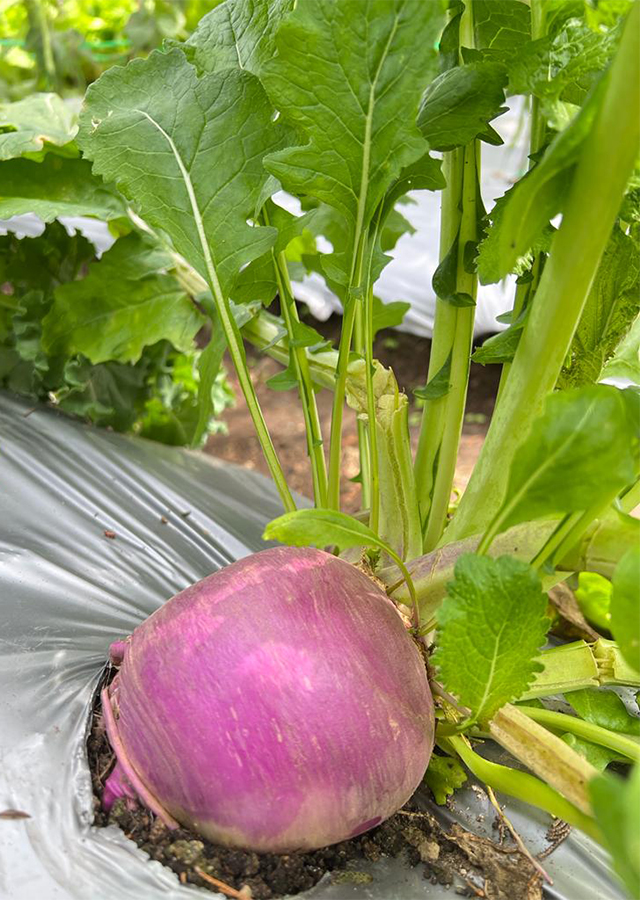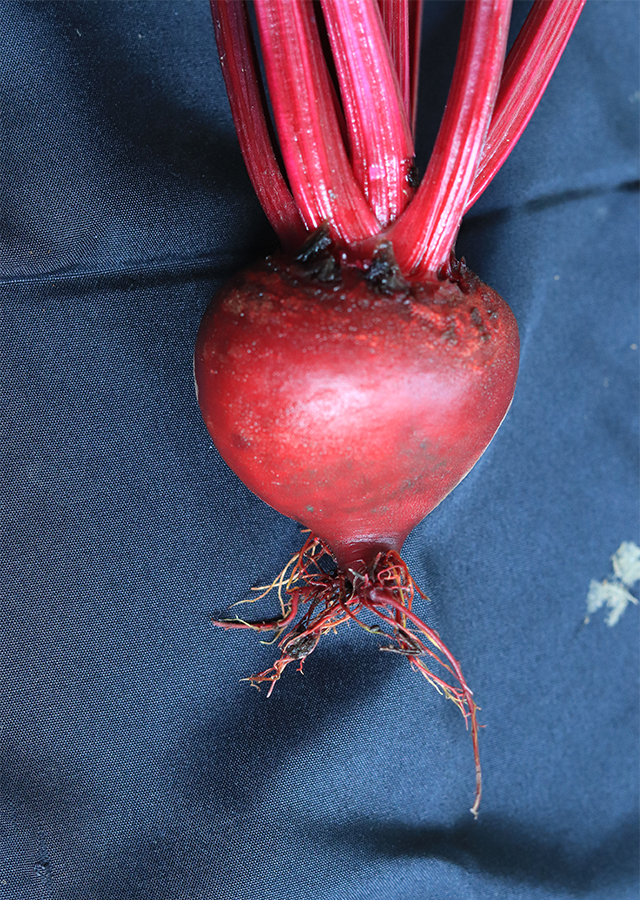Beet
Beta vulgaris L.
Amaranthaceae
Location in our garden
Vegetable



Synonym
Beta alba DC.
Beta altissima Steud.
Beta bengalensis Roxb.
Habitus
Herbaceous. An erect, polymorphic biennial plant (flowering in the second year of growth), grows around 60 cm tall, and up to 2 m tall when in flower.
Part Used
Leaves
Seeds
Roots
Growing Requirements
Need Shade
Habitat
Terrestrial
Overview
Beta vulgaris is native to the Mediterranean, and widely cultivated in America, Europe, and throughout India. Evidence suggests that Beta vulgaris has been cultivated since the 1st century AD, over which time a diverse range of forms have been developed. A cultivated crop that is widely grown, especially in the temperate zone, this species provides the well-known root vegetable 'Beetroot', plus the edible leaves of 'Spinach Beet' and 'Ruby Chard'. The plants are sometimes cultivated in tropical areas and some selected forms with colourful leaves are grown as ornamentals. These include sugar beet, which is a major agricultural crop, providing about 30% of the world's sugar. Beetroot was used medicinally in Ancient Rome and is used in the herbal treatment of cancer today. Beet juice has been recommended to prevent falling hair.
Vernacular Names
Barba (Italian), Remolacha (Spanish), Betterave Potagère (French), Svëkla Obyknovennaia (Russian), Chukandar (India), Aka Kabu (Japanese), Phakkat Daeng (Thai), Hong niu pi cai (Chinese).
Agroecology
In the tropics it needs to be grown at higher elevations if a commercial crop is to be obtained - the leaf beets need to be above 500 metres, whilst the root beets need to be above 1,000 metres. It grows best in areas where annual daytime temperatures are within the range 15-25 °C, but can tolerate 4-35 °C. When dormant, the plant can survive temperatures down to about -6 °C, but young growth can be severely damaged at 0 °C. It prefers a mean annual rainfall in the range 600-1,500 mm, but tolerates 500-2,500 mm. The plant is reported to tolerate an annual precipitation of 230-3,150 mm, an average annual temperature range of 5.0 to 26.6 °C. A very easily grown plant, it succeeds in sun or light shade in moist soils but prefers a rich well-drained light neutral to alkaline soil. Beets grow well in a variety of soils, growing best in a deep, friable well-drained soil abundant with organic matter, but doing poorly on clay. They prefer an open position and a light well-drained soil. The optimum pH is 6.0-6.8, but the plant can tolerate 5-8.3
Morphology
- Root - taproot that develops into tubers, large, fleshy, red, dark to purple, but can also be yellow or white.
- Stem - erect, 30 to 90 cm long.
- Leaves - lower or root leaves are ovate or oblong-obtuse, often trowel-shaped, up to 25 cm long. Upper leaves are rhombic-ovate, oblong-ovate or lanceolate. Basal leaves forming a rosette.
- Flowers - greenish, stalkless, solitary or 2- to 3-adnate, in axillary spikes or corymbose clusters. Spikes are slender, 15 to 45 cm long. Utricle is adnate to the disk and base of the perianth.
- Seed - horizontal with thin testa, floury albumen and annular embryo.
Cultivation
Generatively propagated by seed - sow in situ.
Chemical Constituents
Saponins, betaine phytosterine, betanins, betalains (betacyanin,betaxanthins), isoleucin, leucine, tyrosine, tyrosinase, lysine, arginine, histidine, phenylalanine, urease, flavonoids, neobetain, anthocyanins, pentoses, amino acids, steroids, folic acid.
Traditional Medicinal Uses
- The plant has a long history of folk use, especially in the treatment of tumours.
- Beet juice was formerly recommended as a remedy for anaemia and yellow jaundice, and was put into the nostrils to purge the head, used as ear drops to clear ringing ears, and as a mouthwash to alleviate toothache.
- The root is carminative, emmenagogue, haemostatic, stomachic and is used as a tonic for women. The root can be used as part of the diet, or the juice can be extracted and used as a health-promoting drink. At least one litre of the juice from red-rooted forms must be taken each day in order to stimulate the immune system. The juice is prescribed by herbalists as part of a cancer-treatment regime.
- A decoction prepared from the seed has been used as a remedy for tumours of the intestines. The seed, boiled in water, is said to cure genital tumours.
- The juice has been applied topically to treat ulcers. A decoction is used as a purgative by those who suffer from haemorrhoids in South Africa
Part Used
Reference Sources
- Fern, Ken. (2021). Useful Tropical Plants Database: Beta vulgaris. http://tropical.theferns.info/viewtropical.php?id=Beta+vulgaris. 31-12-2021.
- Kew Royal Botanic Gardens. (2021). Plants of the World Online: Beta vulgaris L. https://powo.science.kew.org/taxon/urn:lsid:ipni.org:names:164505-1. 31-12-2021.
- National Park of Singapore. (2021). Flora Fauna Web: Beta vulgaris (Garden Beet Group). https://www.nparks.gov.sg/florafaunaweb/flora/8/0/8074. 31-12-2021.
- StuartXchange. (2021). Philippine Alternative Medicine: Beet. http://www.stuartxchange.org/Beet.html. 31-12-2021.
- The Plant List. (2013). Beta vulgaris L. http://www.theplantlist.org/tpl1.1/record/kew-2675613. 31-12-2021.
- Nikan, M., Manayi, A. (2019). Beta vulgaris L. Nonvitamin and Nonmineral Nutrition Supplements. https://www.sciencedirect.com/topics/agricultural-and-biological-sciences/beta-vulgaris. 31-12-2021.


